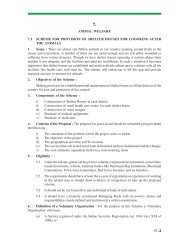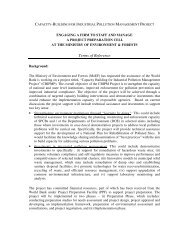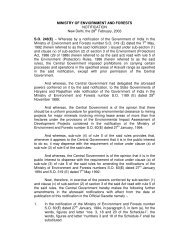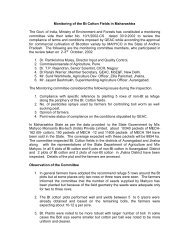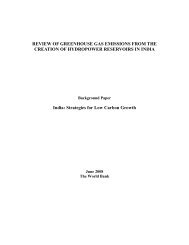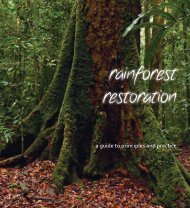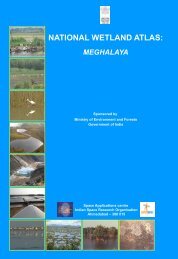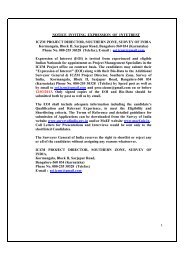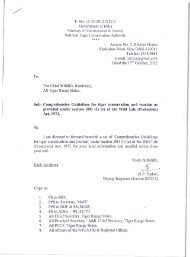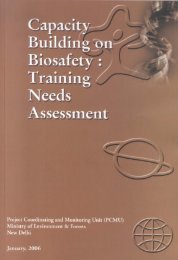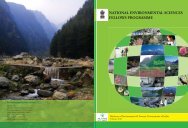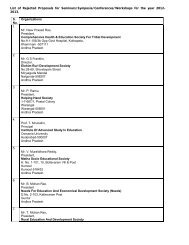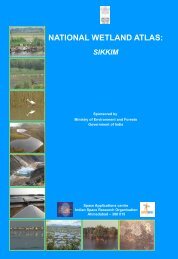pdf - Ministry of Environment and Forests
pdf - Ministry of Environment and Forests
pdf - Ministry of Environment and Forests
- TAGS
- ministry
- forests
- moef.nic.in
Create successful ePaper yourself
Turn your PDF publications into a flip-book with our unique Google optimized e-Paper software.
(xiv) The construction <strong>of</strong> sea walls has been proposed by some States as one <strong>of</strong> the<br />
solutions for preventing damage by tidal waves. However, the construction <strong>of</strong> sea<br />
walls alters long-shore currents <strong>and</strong> modifies coastal geomorphology. In many<br />
places it also causes loss <strong>and</strong> fragmentation <strong>of</strong> coastal habitats. As a result it also<br />
prevents the access to the beach <strong>and</strong> estuaries which marine organisms need for<br />
breeding <strong>and</strong> rearing their young. Estuaries, which serve as habitats <strong>of</strong> mangrove<br />
species will be affected. Structures for preventing coastal erosion should be<br />
located beyond the High Tide Line. Instead <strong>of</strong> building concrete seawalls, it will<br />
be advisable to initiate a programme <strong>of</strong> raising bio-shields <strong>and</strong> coastal green belts.<br />
Construction <strong>of</strong> concrete sea walls can be restricted to areas, which are very<br />
vulnerable to sea erosion.<br />
(xv) S<strong>and</strong> mining is the foremost factor leading to erosion <strong>of</strong> beaches. There are studies<br />
to indicate that at least 21 beaches have been lost in the Nicobar to s<strong>and</strong> mining in<br />
a period <strong>of</strong> ten years. It is critical that alternate <strong>and</strong> environment friendly<br />
technologies for controlling erosion are employed. These include replanting s<strong>and</strong><br />
dune vegetation <strong>and</strong> mangroves where they existed earlier. All natural barriers –<br />
such as coral reefs, mangroves <strong>and</strong> s<strong>and</strong> dunes must be protected at al costs. No<br />
activities that affect these natural assets should be permitted. Earthen bunds can<br />
also be encouraged wherever possible. These activities can be built into coastal<br />
zone management plans <strong>and</strong> can be monitored by the CZMAs. Any structure (hard<br />
measure) should be considered only if s<strong>of</strong>t measures are not possible. The agency<br />
considering the hard measure particularly groins or breakwaters should be<br />
responsible for protecting the shoreline at least 500 mts on either side <strong>of</strong> the<br />
shoreline from erosion. In case <strong>of</strong> breakwaters for harbours, the stretch <strong>of</strong> the<br />
shoreline to be considered for protection should be at least 1.5 km on either side <strong>of</strong><br />
the structure. The agency undertaking the construction <strong>of</strong> the said structures<br />
should be responsible for the monitoring <strong>of</strong> the shoreline for a minimum period <strong>of</strong><br />
one year so as to cover the seasonal variation in the wave climate, which dictates<br />
its dynamics. Here again, the agency responsible for the construction <strong>of</strong> the said<br />
structures should be responsible for the monitoring <strong>of</strong> the shoreline for a minimum<br />
period <strong>of</strong> one year.<br />
(xvi) At locations, where, shoreline advances towards the ocean, due to shore defense<br />
measures undertaken by the Government, construction <strong>of</strong> huts <strong>and</strong> houses should<br />
be totally banned. The local Panchayat could monitor <strong>and</strong> report to the District<br />
Collector or enforcing department. The construction sequence as per the season is<br />
extremely important. This should be spelt out clearly in consultation with an<br />
expert in the field <strong>of</strong> specialization prior to obtaining the necessary<br />
clearance/sanction from the appropriate authority/body. The sizes <strong>of</strong> the stones<br />
usually adopted for the construction <strong>of</strong> seawalls, groins or breakwaters are arrived<br />
at using empirical formulae. If the weight <strong>of</strong> the individual stones used for<br />
construction is underestimated, this would result in the scattering <strong>of</strong> such stones<br />
all over the seafloor resulting in several other problems. (Typical examples are the<br />
seawalls along Royapuram in Tamilnadu, North <strong>of</strong> Paradeep port, a long stretch <strong>of</strong><br />
the coast <strong>of</strong> Karnataka <strong>and</strong> a few other locations). Verification <strong>of</strong> the stability <strong>of</strong><br />
the cover layer <strong>of</strong> these structures through physical modeling in Laboratories is<br />
absolutely essential prior to the commencement <strong>of</strong> such projects.<br />
102



